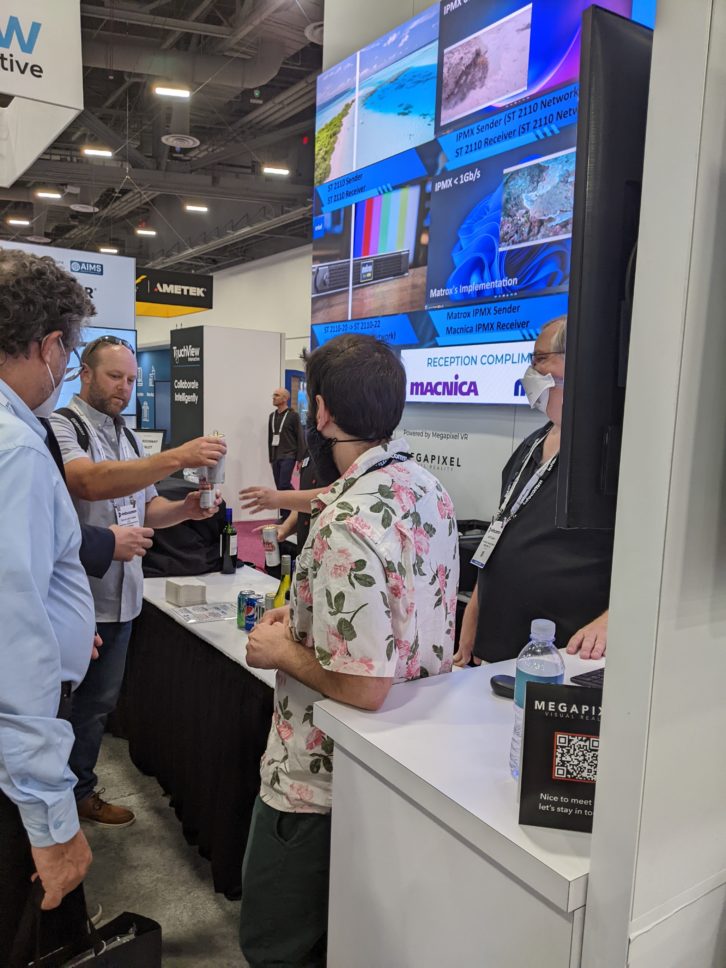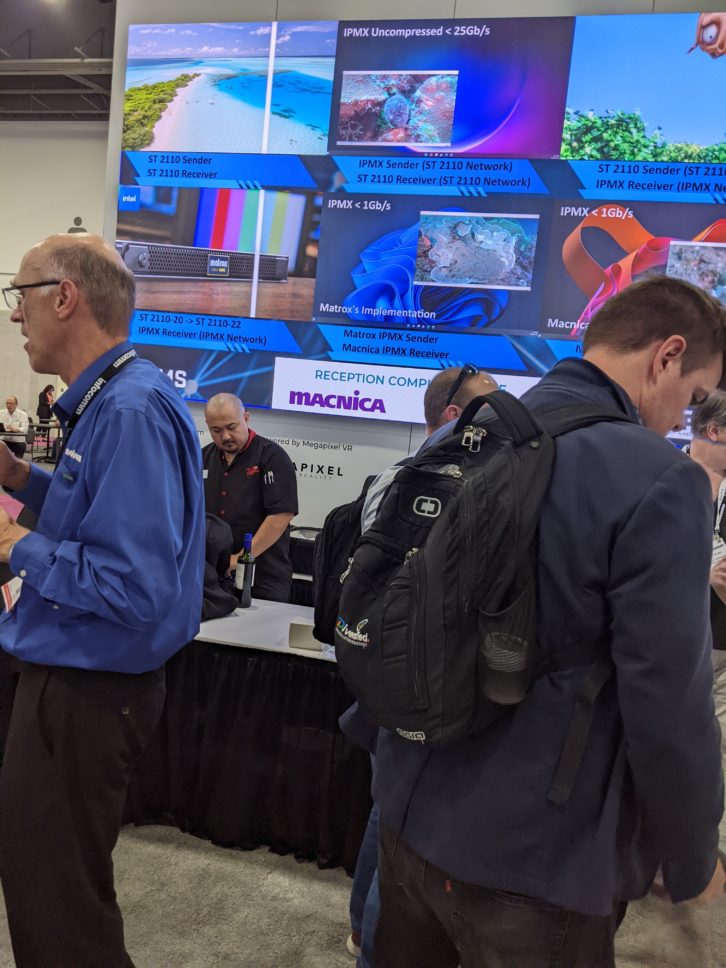The buzz around the IP Media Experience (IPMX) initiative has been growing for several years now, but there’s no doubt that it has reached the ears of more industry stakeholders than ever before during 2022. With more companies joining multiple IPMX-supporting organisations and expressing their desire to make solutions that are compliant with the pro-AV-oriented, AV-over-IP standards and specifications, there is every expectation that the next 12 months will be instrumental in the furtherance of the IPMX project.
Samuel Recine is vice-president of AV/IT Group, Americas & Asia Pacific at Matrox, and pro AV working group chair at AIMS, which – along with SMPTE, AMWA, VSF and JT-NM – is one of the organisations championing IPMX. He remarks: “The number of conversations around IPMX, and the number of companies joining one or more of these organisations to help support the building of the standards or learn how to implement them in their products, has gone up massively in 2022 versus 2021. Momentum is clearly building, as can be seen by the world class interoperability demo of 12 brands that was featured at InfoComm in June, which really highlighted the capabilities. So I am confident that awareness is growing and that soon IPMX will be in even more people’s vocabulary.”

While the AV and media industries have hardly been short of networking initiatives in recent years, the provenance of IPMX meant that it was always going to be a strong contender. For a start, it builds on the foundational standards created by the supporting organisations, including SMPTE’s ST 2110 and AMWA’s NMOS (which was recently the subject of a separate Installation feature. Secondly, the initiative had well-defined aims from the beginning, which included the addition of provisions – including for control, copy protection, connection management and security – bound to resonate with its target market of pro AV.
PRO AV ROADMAP
The development of IPMX stretches back to 2017 – some time before its eventual moniker was adopted. Andrew Starks – board member & marketing workgroup chair at AIMS and director of product management at Macnica Americas – recalls the initial conversations that led to the current programme, which encompasses open standards and specifications geared towards the pro-AV market that enable the carriage of compressed and uncompressed video, audio and data over IP networks for the pro AV market.
“At first the conversation was more about seeing whether we could essentially take ST 2110 as it was and [translate it to] pro AV, and the answer was largely ‘no’,” he says. While there were some products in the field using the standards and “some people took to it, for the most part it was largely ignored” in pro AV.
Thereafter, the conversation moved into defining the capabilities that would have to be addressed: “These included the absence of support for HDCP [High-bandwidth Digital Content Protection] and the kind of HDMI ‘experience’, as I call it, that pro AV users need.” In addition, the “tremendously high pressure on the network” that could occur, as well as the requirement to have PTP (Precision Time Protocol) were earmarked for attention.
“Then we started to work on a pro-AV roadmap, [establishing] what we needed and what are the main use cases,” he says. “We then broke all that into stages and created a working group, at which point the pro-AV-specific work really began.”
From the earliest days, one of the motivating ideas behind IPMX was that it “be suitable for live production and presentation” in a wide range of environments. “So, for example, that could be any university, school or Fortune 1000 company where there is some form of live production gear that needs to be tied into their Zoom gear and their auditorium,” says Starks, going on to highlight the importance of capabilities such as seamless switching and minimal delay.
 The full IPMX roadmap – which encompasses specifications for security, media and control – can be viewed at the project’s website. Many elements are now substantially advanced or finalised, but Starks draws attention to several specifications that are currently in progress, including support for the EDID (Extended Display Identification Data) standard, which automatically communicates manufacturer specification and data between AV source and display devices. This enables the source to send the highest-quality compatible signal data to the device.
The full IPMX roadmap – which encompasses specifications for security, media and control – can be viewed at the project’s website. Many elements are now substantially advanced or finalised, but Starks draws attention to several specifications that are currently in progress, including support for the EDID (Extended Display Identification Data) standard, which automatically communicates manufacturer specification and data between AV source and display devices. This enables the source to send the highest-quality compatible signal data to the device.
A ‘relaxed’ timing mechanism is also in development. “One of the things that we had to adjust was to provide the ability to not have PTP at all. IPMX does not require PTP – it is [only] an option,” says Starks. “That means you are able to dial it way back, so it’s more like AES67 in that way. You do not need to have transparent switches and border clocks; instead, you can get away with more of a looser accuracy.”
Other considerations on the roadmap include support for WAN, WiFi and cloud infrastructures. Racine adds that “USB interoperability [covering] keyboards, mice and so is another thing that is in the works”.
SIGNIFICANT YEAR
All of which leads to the logical question: when might all of this work begin to bear fruit in commercial terms? Starks ventures a prediction: “I think that in terms of being able to make pro-AV interoperable products that include HDCP and all the core connectivity aspects [currently being worked on], it will probably summer next year – [hopefully in time for] InfoComm, I reckon.”
Racine echoes this forecast, suggesting that by summer 2023 “there will be numerous brands promoting the fact that they have IPMX products. One aspect that may evolve in parallel is the possibility of developing IPMX profiles alongside the IPMX standards.” The distinction being that while the IPMX standards encompasses the ST 2110 elements and aforementioned additions, as well as a “very powerful and scalable [model], and a roadmap to keep adding” further provisions, the IPMX profiles would furnish companies with “very tight definitions of what has to be supported to promote a product as being [easy to implement] ‘out of the box’ with ‘no effort required’ interoperability.”
In terms of the pro AV segments likely to register the strongest uptake in IPMX, David Prince is well-placed to make a prediction. He is senior audio architect at newly-signed AIMS member company Panduit, which manufacturers scalable network infrastructure solutions for pro-AV, among other markets. Prince highlights the relevance to “a lot of small to medium sized businesses that [have or want] AV over IP and will need to share those data networks. Add to that the requirement that businesses have for everything to be more secure and easy to use. With IPMX we are able to provide high performance AV over IP using standard gigabit switches – there is no need for 10GbE switches – so that was a prime motivation for working with these technologies.”
Target environments include conference centres and corporate facilities, where IPMX will help enable a configuration that “bridges the gaps between the presentation systems, the broadcast aspects, and the real-time, two-way communications.” Prince also pinpoints possible applications in stadiums and the medical industry.
Recine also identifies the medical and live event industries as key opportunities for IPMX, along with some areas of broadcast “where it might be that what you could call a ‘full ST 2110 environment’” is not required.
BRINGING WAVES
With 2023 expected to bring waves of IPMX-related product announcements, it’s unsurprising that there is a palpable sense of a project approaching a pivotal moment. Accordingly, all three interviewees are optimistic about its outlook, albeit tempered by an awareness of world issues that are beyond their control.
 “Two years from now I think that it will be a significant contributor [to AV over IP usage] and more people will be seeing it as an option for their systems,” says Starks, adding that there must be a preparation for “supply chain issues to have an impact even though it’s an open standard.”
“Two years from now I think that it will be a significant contributor [to AV over IP usage] and more people will be seeing it as an option for their systems,” says Starks, adding that there must be a preparation for “supply chain issues to have an impact even though it’s an open standard.”
This is no small point given that the supply chain crisis – already predicted in many quarters to last well into 2023 – could be further exacerbated by escalating tensions in Asia-Pacific.
Last word to Prince: “I think that we all have a really interesting two years ahead of us. I don’t know where it will take us… I just wish I had a crystal ball!” The hope must be that IPMX can continue to mature and that “people can realise through the pain and unfortunate impact of the supply chain crisis the [benefits of this initiative] and come onboard. Standards work is hard and it’s always easier when you can get people working together. Hopefully there will be scope for everyone to look up and see what IPMX can offer them.”







